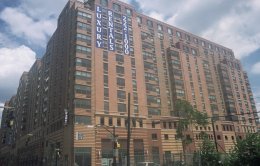
(November 2002)
At the November 6, 2002 City Council caucus, the administration of Mayor David Roberts unveiled for the first time a revised proposal for Block B at Hoboken’s South Waterfront Redevelopment Area. The administration assured everyone that this last of three blocks to be built would be “down-sized.” At the Council meeting that followed, an ordinance to amend the redevelopment plan was given its first reading. But the actual numbers show that the City, contrary to their assertions, is proposing to increase building heights as well as allowable densities for this joint venture with the Port Authority of New York and New Jersey. Building heights for the northern portion of Block B will increase from 125 feet to 160 feet. The over-all density of the South Waterfront Redevelopment Area will exceed the maximum limit of 2.3 million square feet adopted in 1995 by about 100,000 square feet.
On Wednesday afternoon, November 13th, the amendments to the South Waterfront Redevelopment Plan were added to the Hoboken Planning Board’s agenda for that night. Mayor Roberts made a personal appearance to urge the Planning Board to send the amendments back to the City Council with their stamp of approval. Without asking any questions or commenting, the Board assented. The public was not allowed to speak. The ordinance is now coming up for a final vote and public hearing at the City Council’s next meeting on Monday, November 18, twelve days after it was first introduced.
The Mayor has designated SJP Properties as the developer of a massive 175-foot office complex on the southern portion of Block B, between 2nd, Sinatra Drive, 3rd and River Street. For the hotel on the northern end of the block, the Mayor has selected Applied Companies/Starwood Heller as the developer. SJP is the builder of Block A, the first tower of which is now occupied by Wiley and Co., the book publisher. Applied/Starwood Heller are the partners who built 333 River Street which comprises all of Block C. Although the architecture and design for Blocks A and C have been widely criticized, the administration has made no apparent effort to encourage new developers, who would improve the quality of the buildings, to bid on Block B.
The City’s budget for this fiscal year includes an advanced PILOT (payment in lieu of taxes) grant from SJP Properties of $4 million. The City had been facing a budget deficit roughly equivalent to that amount of money. Applied Companies, founded by Joseph Barry and his father in the early 1970’s, has grown to become Hoboken’s largest landlord. The pervasive political influence of Barry in Hoboken has given him the inside track on numerous development projects. (See Hoboken developer Joe Barry targeted by federal investigators.)
The proposed ordinance changes a number of design standards adopted in 1995 by the Hoboken City Council. The requirement to use masonry materials that echo the character of Hoboken would be altered to permit some glass and steel construction. Garage entrances are presently confined to the side streets but the amendments would allow an entrance to the Hotel from River Street. Towers at the northern portion of Block B contradict the concept of stepping down building heights at the northern half of this project.
The development of Hoboken’s south waterfront has been highly controversial. In public referendums in 1990 and 1992, Hoboken voters, led by the Coalition for a Better Waterfront, defeated agreements between the City and the Port Authority of New York & New Jersey to development this property. Much of the opposition to these developments focused on the building heights and the excessive densities. Former Mayor Pasculli set up the Hoboken Waterfront Corporation (HWC), comprised of City officials and community residents, to resolve this dispute. The HWC secured the piers and land at the river’s edge as parkland. They set a maximum build out at 1.8 million square feet and limited building heights to 125 feet. The previous administration with the support of then Councilman David Roberts pushed for a bonus provision that would increase heights at southern portion of this project to 175 feet and over-all density to 2.3 million square feet. Subsequently, this bonus arrangement became the new standard.
David Roberts became Mayor in July of 2001 after a campaign in which he attacked the former Mayor Anthony Russo for encouraging over-development and high-rise construction. At his inauguration, Robert proclaimed that the doors of City Hall were now open and that his would be an “open government.”
FBW News Archive
